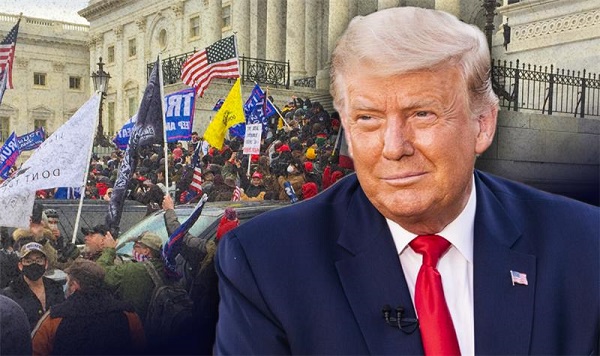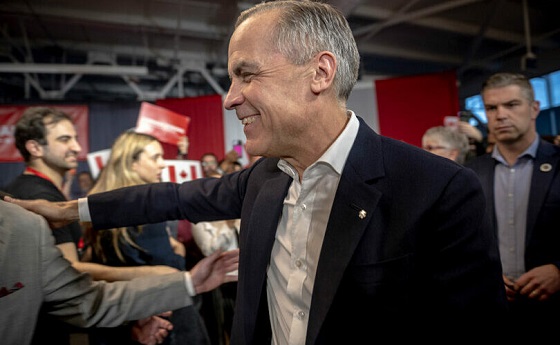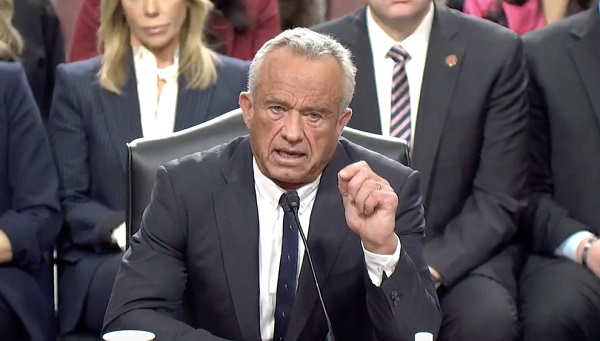International
Bombshell report shows FBI had ‘informants’ in Washington, DC on January 6

From LifeSiteNews
By Stephen Kokx
The FBI had at least 26 “confidential human sources” on the ground in D.C. that day, with three being sent there directly to report on events. The other 23 were allegedly there on their own accord, of which three entered the Capitol while eleven went into the restricted area, purportedly having not been directed to do so by the government.
A bombshell report by the Department of Justice’s Inspector General is being heralded by conservatives as evidence the U.S. government was involved in the January 6 protest on Capitol Hill in 2021.
GOP Congressman Thomas Massie published an X post this week arguing that the report, which confirms that there was more than two dozen FBI “informants” in Washington, D.C. that day, vindicates his many past statements.
“For years I was called a conspiracy theorist for asking … whether government assets participated in J6,” Massie said. “Yesterday I was vindicated. DOJ IG report confirms there were FBI confidential human sources in the crowd, entering the Capitol, and breaking laws.”
Massie informed his X followers that the report additionally reveals that the FBI paid the travel expenses for one of its informants.
The 88-page report garnered headlines from every corner of the political world earlier this week. Among its most alarming findings is that the FBI had at least 26 “confidential human sources” on the ground in D.C. that day, with three being sent there directly to report on events. The other 23 were allegedly there on their own accord, of which three entered the Capitol while eleven went into the restricted area, purportedly having not been directed to do so by the government.
Conservative influencer Charlie Kirk was outraged over the report. In an X post, he asked: “Was this entrapment? Why did it take us four years to learn this?”
BREAKING: An Inspector General Report confirms the FBI had 26 confidential human sources on the ground at J6 and that some of them went into the Capitol.
Was this entrapment?
Why did it take us four years to learn this?Criminal. pic.twitter.com/D1xSyifGdX
— Charlie Kirk (@charliekirk11) December 12, 2024
Incoming Vice President JD Vance has also drawn attention to the report. “For those keeping score at home, this was labeled a dangerous conspiracy theory months ago,” he said on X.
Left-wing media have been quick to point out that the informants were not “agents” and that the report found that they were not “directed” to orchestrate the protest. They say that this debunks Trump’s and other Republican’s long-standing claims that the government was behind the protest.
But Trump and many others have repeatedly spoken about the Deep State’s complicity in the protest in a general way while also pointing out that the corrupt January 6 House Select Committee that included Liz Cheney and other RINO lawmakers withheld evidence that showed the extent of the government’s involvement.
Sports commentator Stephen A. Smith, who does not normally share his opinions on politics, felt the need to opine on the matter given the blatant misinformation the media had spread about it previously.
“I’m really, really sick and tired of every time I turn around, I’m finding something else that the Democrats have lied about or downplayed or misrepresented along the way,” he said on his podcast this week.
“The Democrats worked really, really diligently to make the case that the right had a monopoly on insidious, evil tendencies … we turn around and find out that at least some of them are guilty of the same s—.”
Since Trump’s election, many January 6 prisoners have held out hope that they would receive pardons for their sentences. Trump himself said he would “be acting very quickly” to help them during an interview with MSNBC recently. Former prisoner Leo Kelly of Cedar Rapids, Iowa told LifeSite he hopes Trump will do that soon after he takes office.
Automotive
Hyundai moves SUV production to U.S.

 MxM News
MxM News
Quick Hit:
Hyundai is responding swiftly to 47th President Donald Trump’s newly implemented auto tariffs by shifting key vehicle production from Mexico to the U.S. The automaker, heavily reliant on the American market, has formed a specialized task force and committed billions to American manufacturing, highlighting how Trump’s America First economic policies are already impacting global business decisions.
Key Details:
-
Hyundai has created a tariffs task force and is relocating Tucson SUV production from Mexico to Alabama.
-
Despite a 25% tariff on car imports that began April 3, Hyundai reported a 2% gain in Q1 operating profit and maintained earnings guidance.
-
Hyundai and Kia derive one-third of their global sales from the U.S., where two-thirds of their vehicles are imported.
Diving Deeper:
In a direct response to President Trump’s decisive new tariffs on imported automobiles, Hyundai announced Thursday it has mobilized a specialized task force to mitigate the financial impact of the new trade policy and confirmed production shifts of one of its top-selling models to the United States. The move underscores the gravity of the new 25% import tax and the economic leverage wielded by a White House that is now unambiguously prioritizing American industry.
Starting with its popular Tucson SUV, Hyundai is transitioning some manufacturing from Mexico to its Alabama facility. Additional consideration is being given to relocating production away from Seoul for other U.S.-bound vehicles, signaling that the company is bracing for the long-term implications of Trump’s tariffs.
This move comes as the 25% import tax on vehicles went into effect April 3, with a matching tariff on auto parts scheduled to hit May 3. Hyundai, which generates a full third of its global revenue from American consumers, knows it can’t afford to delay action. Notably, U.S. retail sales for Hyundai jumped 11% last quarter, as car buyers rushed to purchase vehicles before prices inevitably climb due to the tariff.
Despite the trade policy, Hyundai reported a 2% uptick in first-quarter operating profit and reaffirmed its earnings projections, indicating confidence in its ability to adapt. Yet the company isn’t taking chances. Ahead of the tariffs, Hyundai stockpiled over three months of inventory in U.S. markets, hoping to blunt the initial shock of the increased import costs.
In a significant show of good faith and commitment to U.S. manufacturing, Hyundai last month pledged a massive $21 billion investment into its new Georgia plant. That announcement was made during a visit to the White House, just days before President Trump unveiled the auto tariff policy — a strategic alignment with a pro-growth, pro-America agenda.
Still, the challenges are substantial. The global auto industry depends on complex, multi-country supply chains, and analysts warn that tariffs will force production costs higher. Hyundai is holding the line on pricing for now, promising to keep current model prices stable through June 2. After that, however, price adjustments are on the table, potentially passing the burden to consumers.
South Korea, which remains one of the largest exporters of automobiles to the U.S., is not standing idle. A South Korean delegation is scheduled to meet with U.S. trade officials in Washington Thursday, marking the start of negotiations that could redefine the two nations’ trade dynamics.
President Trump’s actions represent a sharp pivot from the era of global corporatism that defined trade under the Obama-Biden administration. Hyundai’s swift response proves that when the U.S. government puts its market power to work, foreign companies will move mountains — or at least entire assembly lines — to stay in the game.
conflict
Trump tells Zelensky: Accept peace or risk ‘losing the whole country’

 MxM News
MxM News
Quick Hit:
President Donald Trump warned Ukrainian President Volodymyr Zelensky that he risks losing Ukraine entirely if he continues resisting a peace settlement. Trump said Moscow is ready for peace, but Kyiv’s refusal to recognize Crimea as Russian territory could derail the effort.
Key Details:
- Trump said Zelensky “can have Peace or… lose the whole Country” and claimed Russia is ready to make a deal.
- Zelensky reiterated Ukraine’s refusal to recognize Russia’s occupation of Crimea, a key sticking point in current peace talks.
- White House press secretary Karoline Leavitt said Trump is frustrated and warned peace efforts may end if no deal is reached this week.
Diving Deeper:
President Trump issued a blunt warning to Ukrainian President Volodymyr Zelensky on Wednesday, saying the Ukrainian leader must choose between accepting peace or facing the collapse of his nation.
“He can have Peace or… fight for another three years before losing the whole Country,” Trump posted on Truth Social. The statement followed Zelensky’s firm declaration that Ukraine “will not legally recognize the [Russian] occupation of Crimea,” a stance at odds with a proposed peace plan under discussion in London between U.S., British, and European officials.
Trump blasted Zelensky’s comment as damaging, declaring, “Crimea was lost years ago under the auspices of President Barack Hussein Obama, and is not even a point of discussion.” The president added that such rhetoric undermines delicate peace negotiations.
Speaking from the Oval Office, Trump said, “I think Russia is ready,” referring to a peace deal, but questioned whether Ukraine is. Kyiv reportedly signed on to a Trump-proposed ceasefire more than a month ago. Trump hinted that progress has been stymied by Zelensky’s reluctance to compromise.
Despite Russian officials signaling a desire to prolong negotiations—with Kremlin spokesman Dmitry Peskov dismissing Trump’s efforts as “futile”—Trump maintained optimism, stating, “I think we have a deal with Russia… we have to get a deal with Zelensky.”
White House press secretary Karoline Leavitt said Trump’s patience is wearing thin. “President Zelensky has been trying to litigate this peace negotiation in the press, and that’s unacceptable,” she said, calling for closed-door diplomacy. “The American taxpayer has funded billions… enough is enough.”
Trump, 78, has consistently criticized Obama for allowing Russia’s 2014 annexation of Crimea to go unanswered. Now, under the Trump administration’s push for peace, a senior official revealed the U.S. is considering recognizing Crimea as Russian territory—a reversal of longstanding American policy based on the 1940 Welles Declaration.
Still, Trump refrained from criticizing Vladimir Putin directly, instead blaming Zelensky for inflammatory statements. “He has nothing to boast about!” Trump said, referencing a heated Feb. 28 Oval Office exchange with Zelensky and Vice President JD Vance.
“I have nothing to do with Russia,” Trump wrote, “but have much to do with wanting to save… five thousand Russian and Ukrainian soldiers a week.”
Trump warned that time is running out: “We are very close to a Deal, but the man with ‘no cards to play’ should now, finally, GET IT DONE.”
With London talks underway and pressure mounting, officials hinted that if no agreement is reached this week, the U.S. could walk away from its efforts in Eastern Europe. Asked whether Trump is ready to give up, Leavitt said, “Not by the end of the day today… but the President… needs to see this thing come to an end.”
-

 2025 Federal Election1 day ago
2025 Federal Election1 day agoCarney’s Hidden Climate Finance Agenda
-

 2025 Federal Election2 days ago
2025 Federal Election2 days agoFormer WEF insider accuses Mark Carney of using fear tactics to usher globalism into Canada
-

 2025 Federal Election15 hours ago
2025 Federal Election15 hours agoTrump Has Driven Canadians Crazy. This Is How Crazy.
-

 2025 Federal Election18 hours ago
2025 Federal Election18 hours agoThe Anhui Convergence: Chinese United Front Network Surfaces in Australian and Canadian Elections
-

 COVID-192 days ago
COVID-192 days agoRFK Jr. Launches Long-Awaited Offensive Against COVID-19 mRNA Shots
-

 Business2 days ago
Business2 days agoTrump considers $5K bonus for moms to increase birthrate
-

 2025 Federal Election24 hours ago
2025 Federal Election24 hours agoStudy links B.C.’s drug policies to more overdoses, but researchers urge caution
-

 2025 Federal Election1 day ago
2025 Federal Election1 day agoConservatives promise to ban firing of Canadian federal workers based on COVID jab status



